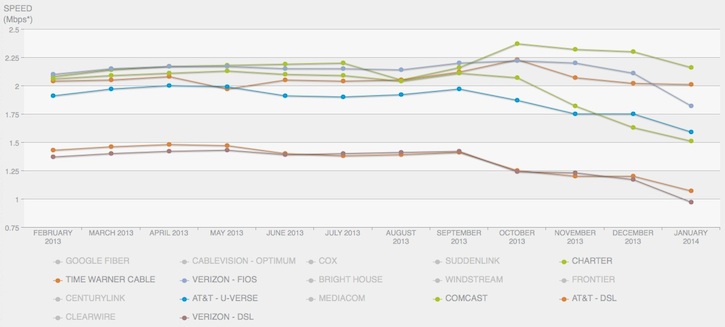
Source: Netflix ISP Speed Index. Click for full results.
The Internet service providers that dominate the Californian market are on a downhill slide, according to the latest speed results from Netflix. Of course, they’re just measuring connections to their Internet video service, but that accounts for almost a third of North American download traffic, so it’s a significant metric.
Wireline download speed results for AT&T, Comcast, Time-Warner, Charter and Verizon peaked in the September-October 2013 time frame and have been falling ever since. The only incumbent with a big presence in California to buck the trend was Cox, which has shown consistent month-to-month performance increases for the past year.
There’s no hard evidence that these ISPs – which compete with Netflix to sell television service – are intentionally throttling streaming video. According to Ars Technica, which looked particularly into the steep drop in Comcast’s and Verizon’s performance, “a likely explanation for recent slowdowns is that Netflix usage went up, but peering and transit bandwidth didn’t”.
It’s the neighborhood cable modem and DSL sharing problem writ large: if you sell fast – 25, 50 Mbps or better – connections to more and more people, but don’t add backhaul capacity at the same rate, those customers will end up getting smaller and smaller bandwidth slices.
The disconnect between the speeds that carriers sell (albeit with an “up to” disclaimer in the fine print) and what consumers actually get continues to grow. Streaming video is particularly rough on broadband infrastructure, but it’s also a primary reason people opt for higher and more expensive tiers of service. How ISPs respond to this gap between advertised supply and customer expectations will play a major role in the ongoing network neutrality debate and could fuel demands for greater regulation.
